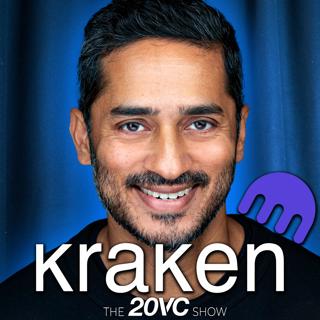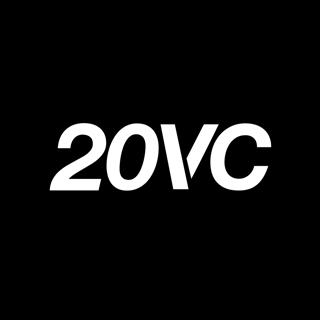
20Growth: Inside Kraken's $1.5BN Growth Playbook: What Works, What Doesn't and What No Founders Understand About Growth That Will Change Their Company with Mayur Gupta
Mayur Gupta is currently the CMO at Kraken, one of the largest crypto platforms in the world. Prior to that, he lead Marketing, Business Transformation and Growth at Gannett - USA Today Network, led Growth at Spotify and was the CMO at Freshly which eventually got acquired by Nestle. He was the first ever Chief Marketing Technologist at Kimberly Clark. In Today's Episode We Discuss: 03:25 Biggest Growth Lessons from Spotify 08:21 Role of Marketing in Product-Led Companies 13:35 How to Build a Growth Engine 20:40 Organic vs. Paid Growth Strategies 27:36 The Branding Dilemma: Performance vs. Brand Marketing 28:37 Creating Demand: The Role of Upper Funnel Marketing 29:35 Balancing Investment: Immediate vs Long Term Bets 30:03 Channel Saturation and Experimentation 31:42 Growth Strategies and Performance Metrics 34:54 Growth: Big Swings or Moving % Points 40:04 Successful Growth Experiments and Tactics 44:56 Quick Fire Questions and Final Thoughts
25 Huhti 52min

20VC: OpenAI's $3BN Acquisition of Windsurf: The Breakdown | Are Endowment Funds F******* & How LP Deployment to Venture Will Change in 2025 | Why Revenue Multiples are BS, The Rise of AI Rollups and Multi-Stage Funds Destroying Seed Investing
In Today's Show We Discuss: 04:49 Breaking Down the $3BN Windsurf Acquisition 06:18 Why Sam Altman is Playing a Master Game 12:40 Why Multi-Stage Funds are Destroying Seed Managers 21:52 Are Endowment Funds F****** 27:38 What Would Rory Do If He Was CFO of an Ivy League Endowment Fund 43:38 The Denominator Effect and It's Impact on Venture Allocations 49:36 Why Revenue Multiple is BS & What You Need to Know 51:34 The Rise of AI Rollup Plays & Are They Good Businesses 55:29 Competitive Markets: How to Make Money in Them? 01:02:58 Why If You Can Guarantee 5x, You Should Always Do the Deal 01:11:56 Is SF The Only Place to Be Building Today
24 Huhti 1h 25min

20VC: Do Rich Founders Make Better Founders | The Best Performing Fund Would Only Back YC Founders on Their Second Time | Why SPACs Will Come Back | Why Short Sellers Should Be Banned | Is Trump Better for Business than Biden with Jason Wilk @ Dave
Jason Wilk is the Founder and CEO of Dave, the greatest turnaround in the public markets of the last 12 months. Dave went public with a market cap of $4BN, just months later the company had a market cap of $50M. Today, they are back with a market cap of $1.1BN. In 2024, CNBC named Dave the best-performing financial stock in the country, achieving 900% growth. In Today's Episode We Discuss: 04:09 Do Rich Founders Make Better Founders 07:45 The Best Performing Fund Would Only Invest in YC Founders on Their Second Time 11:25 "We Went Public Too Late, It Was a Big Mistake" 17:53 Why Did Jason Choose to SPAC? 24:21 Why Does Jason Believe SPACs are Unfairly Demonised and Will Comeback? 29:47 How Does AI Change the Margin Structure of the Next Generation of Companies 33:14 Is Trump Better for Business than a Biden Administration? 38:35 Are We Heading into a Recession? Predictions for Next 12 Months? 46:26 Why Have No Neobanks Reached the Heights of Revolut in the US? 48:08 Why is the Opportunity in Low Income Banking Not High Income in the US? 50:07 Why Short Sellers Should Be Stopped and How Immoral They Are
21 Huhti 58min

20VC: Foundation Models: Who Wins & Who Loses | How Economies and Labour Markets Need to Change in a World of AI | China vs the US in an AI Race: What You Need to Know | Rich Socher, Founder @ You.com
Rich Socher is the Founder and CEO of You.com. Richard previously served as the Chief Scientist and EVP at Salesforce. Before that, Richard was the CEO/CTO of the AI startup MetaMind, which Salesforce acquired in 2016. He is widely recognised as having brought neural networks into the field of natural language processing, inventing the most widely used word vectors, contextual vectors and prompt engineering. He has over 150,000 citations and served as an adjunct professor in the computer science department at Stanford. In Today's Episode We Discuss: 04:10 Winners & Losers: OpenAI, Gemini, Claude 08:59 How Partnerships Could Decide the Winners in AI 12:42 China vs US: Who Wins the War for AI 25:50 How Society and Economics Needs to Change in a World of AI 34:04 What Jobs Will Be Replaced, What Will Not 36:04 How Europe Needs to Change It's Approach to AI 41:06 How AI Will Change Health and Longevity 43:10 AI in Consumer and Enterprise Markets 49:30 Quantum Computing and AI Misconceptions 56:57 Longevity, Personal Reflections, and Future Outlook Please read the offering circular and related risks at invest.modemobile.com. This is a paid advertisement for Mode Mobile's Regulation A+ Offering. Past performance is no guarantee of future results. Investing in private company securities is not suitable for all investors because it is highly speculative and involves a high degree of risk. It should only be considered a long-term investment. You must be prepared to withstand a total loss of your investment. Private company securities are also highly illiquid, and there is no guarantee that a market will develop for such securities. DealMaker Securities LLC, a registered broker-dealer, and member of FINRA | SIPC, located at 105 Maxess Road, Suite 124, Melville, NY 11747, is the Intermediary for this offering and is not an affiliate of or connected with the Issuer. Please check our background on FINRA's BrokerCheck.
18 Huhti 1h 3min

20VC: Why Seed is for Suckers | a16z's $20BN Fund & Founders Fund's $4.6BN: What Makes Them So Good | Why Josh Kushner Is the Master of Venture Capital Strategy | Why Extended Private Markets Screw US Citizens with Jason Lemkin and Rory O'Driscoll
Jason Lemkin is one of the leading SaaS investors of the last decade with a portfolio including the likes of Algolia, Talkdesk, Owner, RevenueCat, Saleloft and more. Rory O'Driscoll is a General Partner @ Scale where he has led investments in category leaders such as Bill.com (BILL), Box (BOX), DocuSign (DOCU), and WalkMe (WKME), among others. In Today's Episode We Discuss: 04:23 What is Wrong with Billionaires on Twitter: Are They Depressed? 08:49 Why Does product Market Fit Mean Less Than Ever 11:50 Why is Venture Capital More Risky Than Ever and No One is Discussing It 16:17 Will Private Equity Save a Generation of SaaS Companies and VCs 23:53 a16z's $20BN Fund: Seriously? 31:29 Why Josh Kushner and Thrive Capital are Masters of the World 38:21 Why is Seed Investing for Suckers 45:49 Why Are $50 Million Seed Funds Useless 46:21 Founders Fund Raises $4.6BN: Analysis 52:00 How WIll LPs Change Their Approach to Venture in the Next Five Years 59:53 When Will IPOs Comeback? 01:09:15 Why Does it Not Make Sense for the Best Companies to IPO 01:09:51 Lost Ethics and Morals in Founder Secondaries and Term Sheets 01:22:58 Quickfire: OpenAI, Cursor, Deel vs Rippling
17 Huhti 1h 29min

20VC: Benchmark's Victor Lazarte on Why Portfolio Construction is BS| Why SaaS Spreadsheet Investing is Dead | Why China is a Stabilising Force for the US | Three Traits All the Best Founders Have & The Lie All Big Tech Companies Have Been Telling
Victor Lazarte is a General Partner @ Benchmark, one of the mot renowned venture firms in the world. At Benchmark, Victor has led deals into the likes of HeyGen and Mercor. As an angel, he was the first investor and board member of Brex, and as a Founder he scaled Wildlife Studios, bootstrapping into the largest gaming company in LatAm, with about 4 billion downloads. In Today's Episode We Discuss: 04:10 Lessons Scaling Wildlife Studios to 4BN Downloads 04:49 Why Predicting the Future is Wrong When Starting a Company 07:11 Three Different Categories of Company in an AI World: Who Wins & Loses? 09:25 Why You Should Always Ask What a Founder Does in Their Free Time? 17:30 Two Traits That All the Best Founders Have? 23:17 Why If You Start a Company in SF You are 1,000x More Likely to be Successful? 35:30 Why Spreadsheet SaaS Investing is Dead 36:10 Why Replacing Humans is the Most Exciting Opportunity in AI 37:02 Why Knowledge Work Will Be Destroyed and What Happens Then? 37:30 Why China is a Stabilising Force for the US 38:59 China vs. US: The AI Race 42:33 Why All Students Today Should Study Computer Science 44:38 Why Portfolio Construction is BS 47:04 What Makes Peter Fenton One of the Best Ever 51:31 Why Duolingo Will Be One of the Most Valuable Companies in the World 01:00:17 Quick Fire Round: Insights and Predictions
14 Huhti 1h 7min

20Product: How Scale AI and Harvey Build Product | Why PMs Are Wrong: They are not the CEOs of the Product | How to do Pre and Post Mortems Effectively and How to Nail PRDs | The Future of Product Management in a World of AI with Aatish Nayak
Aatish Nayak is the Head of Product at Harvey where he oversees product vision, strategy, design, analytics, marketing, and support. This is his third hypergrowth AI unicorn having previously held product leadership roles at Scale AI from 40 to 800 people, and Shield AI from 20 to 100 people. In Today's Episode We Discuss: 04:21 Biggest Product Lessons from Scale AI 7:18 Why Product Managers Are Wrong: They are not the CEO of the Product 12:28 Why Market Selection is More Important than Anything Else 16:40 If Distribution is King then Product is President 22:06 Effective Product Strategy and Execution 26:24 How to Write the Best PRDs 31:01 Balancing New Features and Technical Debt 33:17 Analysing Retrospectives and Postmortems 33:55 Introduction to Pre-mortems 38:25 Biggest Product Mistakes and Lessons Learned 41:40 Evaluating AI Models and Lessons Learned 45:03 The Future of AI in Product Management 55:21 What Should Product People Learn to Win in a World of AI 59:37 The AI Talent War in San Francisco 01:01:26 Quickfire Round
11 Huhti 1h 5min

20VC: How to Fix the UK Tech Ecosystem | Why We Need to Flood the UK with Venture Capital | What the UK Can Learn From Sequoia, Stripe and Norway | Why Now is the Time to be Bullish on China & Lessons from Jensen Huang with Tom Hulme & Stan Boland
Tom Hulme is a General Partner @ GV and leads GV's European investing. He has led rounds in Monzo, Nothing, GoCardless, Lemonade, Snyk and is widely considered one of the best investors in Europe. Stan Boland is one of the most successful and respected entrepreneurs in the UK. In 1999, he co-founded Element 14 which was acquired by Broadcom in 2000 for $640 million. Following this, Boland co-founded Icera Inc. in 2002, a fabless semiconductor company which he sold to Nvidia for $367 million. In Today's Discussion We Cover: 04:26 Is The UK's Biggest Problem a Talent Problem 09:50 Why We Need to Flood the UK With Venture Capital 10:38 What Europe Can Learn from Stripe and the Collisons 15:21 How the UK Can Use Visas to Retain the Best Talent 16:46 Why the Government Needs to Put 10x More Cash Into Fund of Funds 24:32 Is the London Stock Exchange F****** and Does it Matter? 34:38 What The UK Can Learn From Sequoia and the Norwegian Sovereign Wealth Fund 40:42 What is a "National Goal for Wealth Creation" & How Do We Implement It? 48:10 What are the Most Broken Elements of the UK Tax Regime 52:11 Is It Stupid to Remove the Non-Dom Tax Status 53:15 Why is Now the Time to Be Bullish on China 01:00:19 Biggest Lessons from Working with Jensen Huang 01:08:04 Quick Fire Round: Insights and Predictions
10 Huhti 1h 24min






















